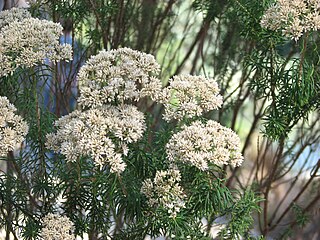
Cassinia aculeata, commonly known as common cassinia, dolly bush or dogwood , is a species of flowering plant in the family Asteraceae and is endemic to south-eastern Australia. It is an erect shrub with sessile, linear, variably-sized leaves, and heads of creamy-white to white flowers arranged in rounded cymes.

Cassinia laevis, commonly known as cough bush, dead finish, curry bush or rosemary bush, is a species of flowering plant in the family Asteraceae and is endemic to south-eastern continental Australia. It is a shrub with a curry-like odour, crowded linear leaves, and heads of creamy-white flowers arranged in panicles.
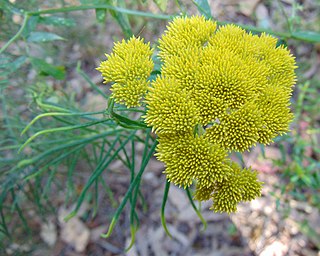
Cassinia leptocephala is a species of flowering plant in the family Asteraceae and is endemic to New South Wales. It is a large, woody shrub with hairy, reddish stems, stiff linear leaves, and heads of pale yellow flowers arranged in a dense corymb.
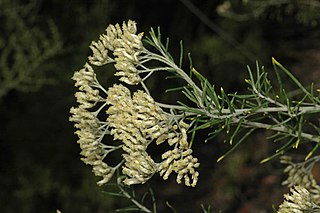
Cassinia uncata, commonly known as sticky cassinia, is a species of flowering plant in the family Asteraceae and is native to inland New South Wales and the south-east of South Australia. It is an erect shrub with hairy young stems, narrow linear to needle-shaped leaves, and heads of off-white to cream-coloured flowers arranged in rounded, almost conical panicles.

Cassinia subtropica, commonly known as bushy rosemary, is a species of flowering plant in the family Asteraceae and is endemic to north-eastern Australia. It is shrub with woolly-hairy stems, lance-shaped to egg-shaped leaves and panicles of flower heads.
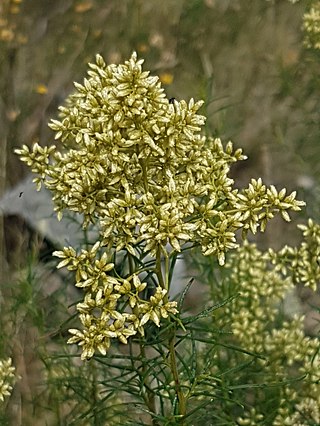
Cassinia quinquefaria is a species of flowering plant in the family Asteraceae and is endemic to eastern Australia. It is a shrub with sticky, hairy foliage, linear leaves, and heads of creamy-white flowers arranged in a dense panicle.

Cassinia longifolia, commonly known as shiny cassinia, is a species of flowering plant in the family Asteraceae and is endemic to eastern Australia. It is an erect, aromatic shrub with sticky, hairy foliage, linear or oblong to narrow lance-shaped leaves, and heads of creamy-white flowers arranged in a dense corymb.
Cassinia copensis is a species of flowering plant in the family Asteraceae and is endemic to eastern Australia. It is an erect, multi-stemmed shrub with aromatic, cylindrical leaves, and heads of creamy-white flowers arranged in a flattened corymb.
Cassinia hewsoniae is a species of flowering plant in the family Asteraceae and is native to New South Wales and the Australian Capital Territory. It is an erect shrub with a sticky, densely-hairy stems, needle-shaped leaves and flower heads arranged in flat or rounded corymbs.
Cassinia maritima commonly known as coast cassinia, is a species of flowering plant in the family Asteraceae and is endemic to coastal areas of south-eastern Australia. It is an erect shrub with glandular hairs embedded in a sticky layer on its branches and leaves, needle-shaped leaves, and white to yellowish heads of flowers arranged in a flat-topped corymb.
Cassinia monticola commonly known as mountain cassinia, is a species of flowering plant in the family Asteraceae and is endemic to mountain areas of south-eastern Australia. It is a spreading shrub with sticky, narrow linear to narrow lance-shaped leaves, and bronze-coloured to greenish-cream heads of flowers arranged in a dense, round-topped corymb.
Cassinia ochracea is a species of flowering plant in the family Asteraceae and is endemic to south-eastern New South Wales. It is an erect or spreading shrub with hairy stems, needle-shaped leaves and flat or rounded corymbs of up to four hundred flower heads.
Cassinia telfordii is a species of flowering plant in the family Asteraceae and is endemic to eastern Australia. It is an erect shrub with hairy young stems, linear leaves and corymbs of up to several hundred yellow to cream-coloured flower heads.
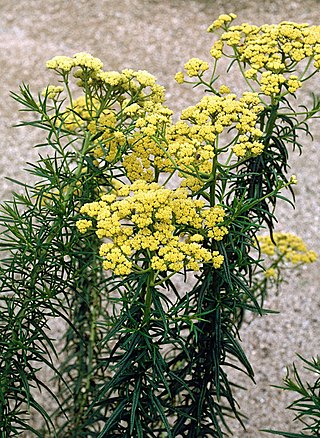
Cassinia venusta is a species of flowering plant in the family Asteraceae and is endemic to a small area near the border between New South Wales and Victoria. It is an erect shrub with glandular-hairy branchlets, glossy green, needle-shaped leaves, and corymbs of hundreds to thousands of yellowish flower heads.

Cassinia lepschii is a species of flowering plant in the family Asteraceae and is endemic to eastern Australia. It is an erect or spreading shrub with densely hairy young stems, needle-shaped leaves and flower heads arranged in flat or rounded corymbs.
Cassinia accipitrum is a species of flowering plant in the family Asteraceae and is endemic to eastern New South Wales. It is an erect shrub with spreading, dark green leaves that are covered with cottony hair on the underside, and heads of yellowish brown flowers arranged in rounded cymes.
Cassinia heleniae is a species of flowering plant in the family Asteraceae and is endemic to a small area in northern New South Wales. It is a shrub with a few sticky stems, sticky needle-shaped leaves and flower heads arranged in a rounded to flat-topped cyme.
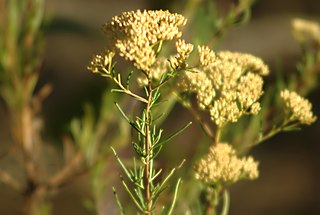
Cassinia scabrida commonly known as rough cassinia, is a species of flowering plant in the family Asteraceae and is endemic to forests with rocky granite outcrops in north-eastern Victoria, Australia. It is an erect shrub with hairy foliage, linear leaves, and large numbers of greenish-white heads of flowers arranged in dense corymbs.

Cassinia wilsoniae is a species of flowering plant in the family Asteraceae and is endemic to a small area near the border between South Australia and Victoria. It is an erect shrub with densely hairy branchlets, needle-shaped leaves, and corymbs of twenty to fifty ochre-coloured flower heads.
Cassinia thinicola is a species of flowering plant in the family Asteraceae and is endemic to coastal New South Wales. It is a compact shrub with hairy young stems, needle-shaped to slightly flattened leaves, and corymbs of up to 150 flower heads.











